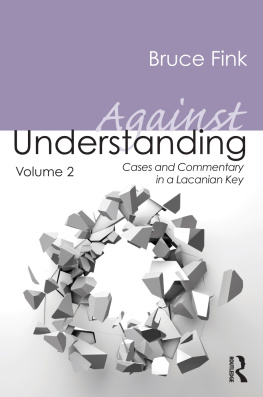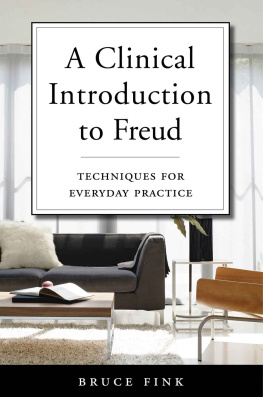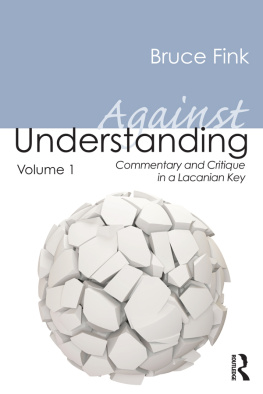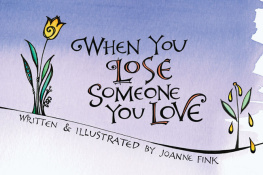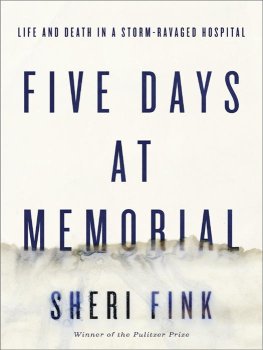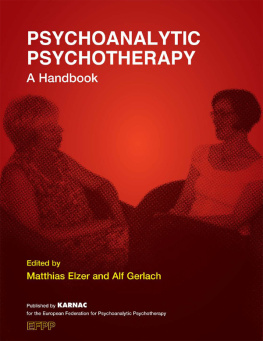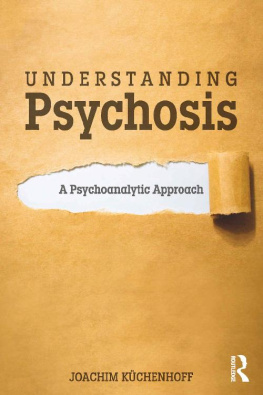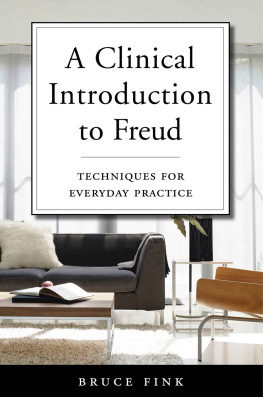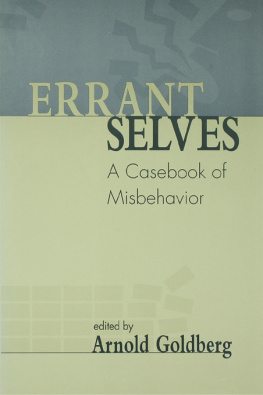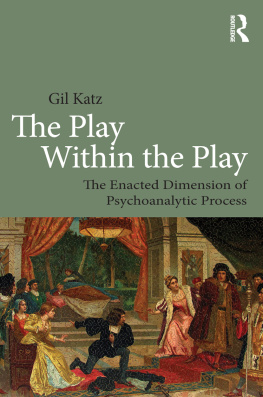
AGAINST UNDERSTANDING, VOLUME 2
Against Understanding, Volume 2 casts a spotlight on the status of case studies in psychoanalysis, which are commonly used to illustrate clinicians expertise and mastery rather than patients actual itineraries. When a case is presented, the complex, unwieldy, and often self-contradictory material of a therapeutic trajectory tends to be vastly oversimplified in view of producing a linear narrative that seems to perfectly fit the parameters of a practitioners preferred theoretical framework.
Bruce Fink attempts to eschew the appearance of mastery in assembling clinical material and in discussing his approach to practice and theory in the myriad case histories and vignettes included in both Volumes 1 and 2 of Against Understanding. To counterbalance the kind of paring down of material usually carried out to make cases conform to a particular paradigm, the case write-ups presented here include much of the raw data so often omitted: verbatim quotes from patients about their lives, backgrounds, dreams, and fantasies; and details about the many obscure, vacillating, and unruly phases of treatment. Fink hopes thereby to allow readers to form their own opinions about the well-foundedness or unsoundness of his formulations, interpretations, and interventions.
This second part of a two-volume collection of papers, interviews, and case studies provides the reader with hundreds of illustrations of Lacanian theory in practice, and will be essential for psychoanalysts, psychotherapists, psychiatrists, psychologists, social workers, and counselors.
Bruce Fink is a practicing Lacanian psychoanalyst and analytic supervisor in Pittsburgh, Pennsylvania. He trained as a psychoanalyst in France for seven years withand is now a member ofthe psychoanalytic institute Lacan created shortly before his death, the cole de la Cause Freudienne in Paris. He is also an affiliated member of the Pittsburgh Psychoanalytic Society and Institute.
AGAINST UNDERSTANDING, VOLUME 2
Cases and Commentary in a Lacanian Key
Bruce Fink

First published 2014
by Routledge
27 Church Road, Hove, East Sussex BN3 2FA
and by Routledge
711 Third Avenue, New York, NY 10017
Routledge is an imprint of the Taylor & Francis Group, an informa business
2014 Bruce Fink
The right of Bruce Fink to be identified as author of this work has been asserted by him in accordance with sections 77 and 78 of the Copyright, Designs and Patents Act 1988.
All rights reserved. No part of this book may be reprinted or reproduced or utilised in any form or by any electronic, mechanical, or other means, now known or hereafter invented, including photocopying and recording, or in any information storage or retrieval system, without permission in writing from the publishers.
Trademark notice: Product or corporate names may be trademarks or registered trademarks, and are used only for identification and explanation without intent to infringe.
British Library Cataloguing in Publication Data
A catalogue record for this book is available from the British Library
Library of Congress Cataloging in Publication Data
Fink, Bruce, 1956
Against understanding : commentary, cases and critique in a Lacanian key / authored by Bruce Fink.
pages cm
Includes bibliographical references and index.
ISBN 978-0-415-63542-4ISBN 978-0-415-63543-1
1. Comprehension. 2. Psychology. I. Title.
BF325.F56 2014
150.195dc23
2013009094
ISBN: 978-0-415-63546-2 (hbk)
ISBN: 978-0-415-63547-9 (pbk)
ISBN: 978-1-315-88403-5 (ebk)
Typeset in Times New Roman
by RefineCatch Limited, Bungay, Suffolk
TO HLOSE
The space occupied by not understanding is the space occupied by desire. It is to the extent that this is not perceived that an analysis ends prematurely and is, quite frankly, botched.
Lacan, 2001a, p. 250
CONTENTS
6 An Introduction to Lacans Seminar XVIII:
Dun discours qui ne serait pas du semblant
| L Schema (simplified) |
| L Schema for obsessives |
| Bouasses inverted bouquet illusion |
| Lacans first optical schema |
| Plate VIII: Caduveo womans drawing representing a figure with a painted face |
| Family crest mask closed |
| Family crest mask open |
| Coat of arms of the Duke of St. Albans |
| Sadism in crits |
| Hamlets trajectory |
| Sadistic desire in Seminar X |
| Masochism in crits |
| Sadism |
| Masochism, example of Sade |
| Sades masochistic maxim |
| Sades masochism |
| Schema X |
| Schema Y |
Because they understand a lot of things, analysts on the whole imagine that to understand is an end in itself, and that it can only be a happy end. The example of physics may show them, however, that the most impressive successes do not require that one know where one is going.
Lacan, 2006a, p. 615
Lacanian psychoanalysis is usually presented as little more than a theory by most authors in the English-speaking world. Clinical work based on Lacanian principles is rarely presented in our contemporary literature, much less compared with clinical work based on other principles.
Almost half of the material included in the present two-volume collection is clinical in nature, some of it brief clinical vignettes, but much of it somewhat in-depth case studies (see, for example, in Volume 1). A number of comments on case presentations thus seem to me to be in order here.
What Is a Case Study?
[Freud] would rather give up the entire stability of his theory than misrecognize the tiniest particularities of a case that might call his theory into question.
Lacan, 2006a, pp. 38586
What could be more reductionistic and, indeed, scandalous, than a case study? Perhaps nowhere in the practitioners work world is the temptation so great to squeeze mountains of unwieldy clinical material into a theoretical frame, and to use a patients complex and circuitous pathway through an analysis to demonstrate the value of some particular technique or concept. In The Two Analyses of Mr. Z, the eminent psychoanalyst Heinz Kohut (1994) had the unmitigated gall to invent lock, stock, and barrel an analysis he never conducted to promote his own way of supposedly practicing: he presented the traditional Freudian analysis he himself had undergone as part of his training as though it were someone elses, and then invented a second self-psychology informed analysis for this same man as though Kohut had been the mans analyst. Talk about solipsism!
It seems to me that case presentations are, almost by their very nature, destined to oversimplification and exaggeration, and to be skewed, corralled, and even shanghaied into serving the writers own purposes, for most of them are written up and published largely for reasons of self-promotion. Authors of case histories are very often seeking to publicize their own availability, assert their own clinical and/or theoretical prowess, and at times even convince the public of their superiority over all other available practitioners. Rare is the clinician who admits in print to having been in a serious muddle about what was going on for his patient, to having made obvious mistakes in the course of the treatment, and/or to not having had a clue as to his patients diagnosisunless, of course, this is admitted to as having been the case at an early stage of the treatment, but as having given way to a complete understanding of the situation later on.
Next page
